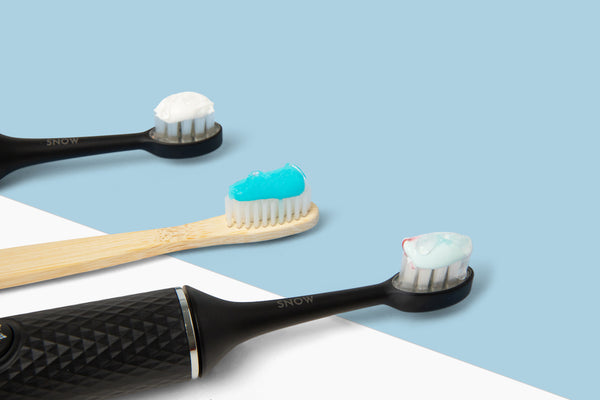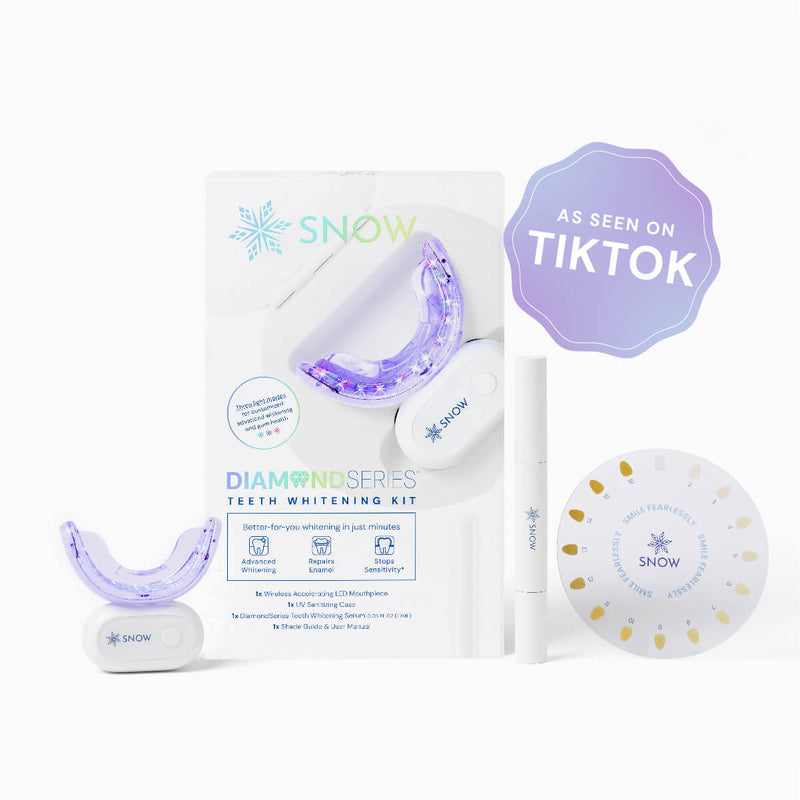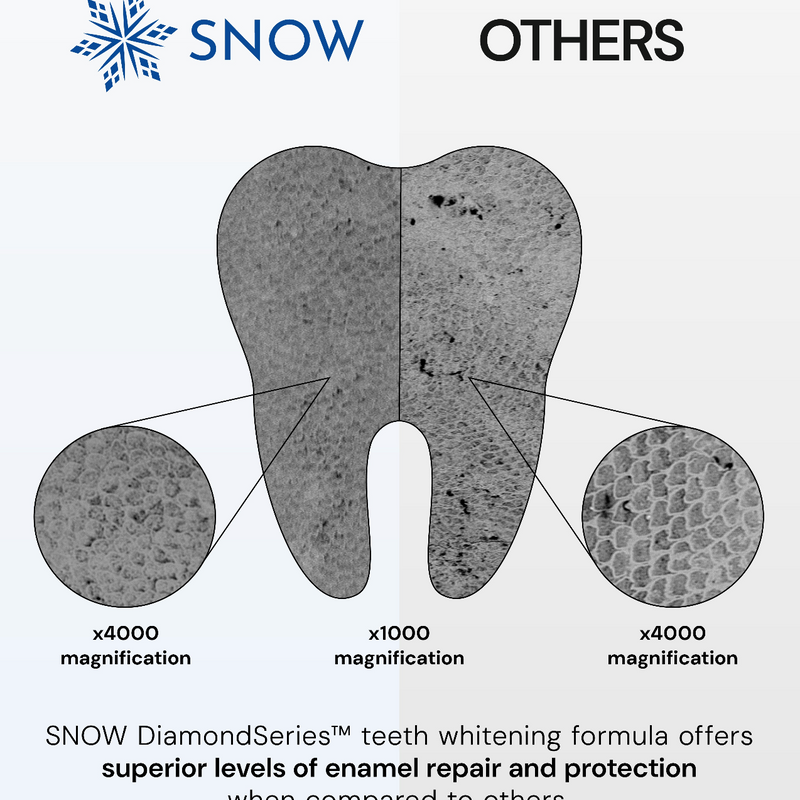Wondering how to clean your toothbrush with vinegar? Yes, you can disinfect your toothbrush effectively using vinegar, ensuring optimal oral hygiene and safety.
In this guide, SNOW, your expert in dental health and at-home teeth whitening, will provide you with step-by-step instructions on cleaning and disinfecting your toothbrush with vinegar.
Moreover, understanding the importance of a clean toothbrush is essential for maintaining oral health and ensuring your brushing is effective."
We'll cover various methods, including soaking your toothbrush in a vinegar solution and the benefits of using vinegar for disinfection.
Additionally, we'll address common questions about toothbrush hygiene, such as how long bacteria stay on a toothbrush and the best practices for toothbrush storage.
With SNOW's expertise, you'll learn how to maintain a clean toothbrush for a brighter and healthier smile.
What this article covers:- How to Clean Electric Toothbrush with Vinegar
- How to Disinfect a Toothbrush with Vinegar
- How to Keep a Toothbrush Clean
- Toothbrush Tips
- Cleaning Toothbrush FAQs
How to Clean Electric Toothbrush With Vinegar
Electric toothbrushes are essential for maintaining oral hygiene effectively. To ensure their longevity and optimal performance, proper cleaning is crucial.
When it comes to cleaning electric toothbrushes, vinegar can be a simple yet effective method to ensure they are free from bacteria and germs
To clean your electric toothbrush with vinegar, begin by removing the brush head from the handle.

Then, fill a cup with white vinegar and submerge the brush head in the vinegar solution.
Let it soak for approximately 15 minutes to ensure thorough disinfection.
After soaking, rinse the brush head thoroughly with water to remove any vinegar residue. Ensure the brush head is completely dry before reattaching it to the handle and storing it in a clean, dry place.
Regularly cleaning your electric toothbrush with vinegar can help maintain its cleanliness and hygiene, promoting a brighter and healthier smile.
Can You Disinfect A Toothbrush With Vinegar?
Yes, you can disinfect an electric toothbrush with vinegar, as it's effective in killing most germs and bacteria.
Vinegar has been proven to be an efficient disinfectant, capable of killing most germs and bacteria. Its acidic nature helps break down and eliminate bacteria and germs that may accumulate on your toothbrush over time.
By soaking your toothbrush in a vinegar solution, you can ensure that it remains clean and free from harmful microorganisms.
Regularly disinfecting your toothbrush with vinegar is a simple yet effective way to maintain oral hygiene and reduce the risk of bacterial contamination.
This method is especially useful for individuals who may be concerned about the cleanliness of their toothbrushes and want to ensure proper hygiene practices.
Incorporating vinegar into your toothbrush cleaning routine can contribute to a healthier oral care regimen, promoting a brighter and healthier smile.
How to Disinfect a Toothbrush with Vinegar
In this section, we'll discuss how to effectively disinfect a toothbrush at home using a simple vinegar solution. Keeping your toothbrush clean is crucial for maintaining oral hygiene, and disinfecting it regularly helps eliminate harmful bacteria and germs.
According to WikiHow, white vinegar is an effective disinfectant for toothbrushes.
Here's how you can do it:
Prepare The Solution
Mix equal parts of white vinegar and water in a cup or container. Vinegar's acidic properties help break down bacteria and germs, ensuring thorough disinfection.
Soak The Toothbrush
Submerge the toothbrush head in the vinegar solution for at least 30 minutes. This extended soaking time ensures that the bristles are fully disinfected.
Rinse Thoroughly
After soaking, rinse the toothbrush under tap water to remove any remaining vinegar residue. This step ensures that no vinegar taste or smell remains on the toothbrush.
Following these simple steps regularly will help keep your toothbrush clean and free from harmful bacteria, promoting better oral health and a brighter smile.

How to Keep a Toothbrush Clean
Maintaining the cleanliness of your toothbrush is essential for optimal oral hygiene.
At SNOW, we not only prioritize effective teeth whitening but also advocate for proper toothbrush care to complement your bright smile.
Here are some tips to keep your toothbrush clean:
Store Properly
Store your toothbrush upright in a holder to allow proper air circulation and drying between uses. Avoid covering it, as damp environments can foster bacterial growth.
Consider upgrading to SNOW's LED Teeth Whitening Electric Toothbrush, designed with innovative features to promote cleanliness and enhance your whitening routine.
Replace Regularly
Regularly buy a new toothbrush or install one of your new replacement toothbrush heads every 3 to 4 months, or sooner if bristles appear frayed or worn.
SNOW offers the Advanced Whitening Electric Toothbrush, engineered for durability and longevity, ensuring you always have a fresh and effective tool for maintaining your bright smile.
It's also wise to remember to change your toothbrush after you are sick to prevent recontamination and maintain the best oral health practices.
Following these simple steps will help maximize the effectiveness of your teeth whitening routine and ensure optimal oral health.
Toothbrush Tips
Proper toothbrush care is crucial for maintaining good oral hygiene and maximizing the effectiveness of your teeth whitening routine. At SNOW, we understand the importance of keeping your toothbrush clean and hygienic. Here are some valuable tips to ensure your toothbrush stays in top condition:
Avoid Sharing
Sharing toothbrushes is a big no-no! It increases the risk of spreading harmful bacteria and infections between users.
Each person should have their own toothbrush to maintain oral health and hygiene.
Clean Regularly
Regularly cleaning your toothbrush is essential to remove any accumulated bacteria and debris.
WebMD suggests soaking it in a solution of white vinegar and water once a week to effectively disinfect it.
Store Properly
Proper storage is key to keeping your toothbrush clean. Store it upright in a well-ventilated area to allow it to air dry between uses.
Avoid storing it in closed containers or covering it, as this can promote bacterial growth.

Replace When Necessary
Know when it's time to say goodbye to your toothbrush. Replace it every 3 to 4 months, or sooner if the bristles become frayed or worn out.
A fresh toothbrush ensures effective cleaning and whitening results.
Rinse After Use
After brushing, thoroughly rinse your toothbrush under running water to remove any remaining toothpaste and debris.
This simple step helps keep your toothbrush clean and ready for the next use.
Following these tips will help you maintain a clean and hygienic toothbrush, ensuring optimal oral health and a radiant smile.
Cleaning Toothbrush FAQs
How long do bacteria stay on a toothbrush?
Bacteria can linger on a toothbrush for extended periods, especially if not properly cleaned. Regular cleaning and disinfection can help minimize bacterial growth.
Where is the cleanest place to store your toothbrush?
To maintain hygiene, store your toothbrush upright in a clean, dry area away from the toilet and sink.
This minimizes exposure to airborne bacteria and water splashes, ensuring a clean toothbrush.
How do you know when it's time to change your electric toothbrush head?
It's time to replace your electric toothbrush head when the bristles become worn, frayed, or splayed.
Using a worn brush head can compromise oral hygiene by being less effective at removing plaque and debris.
Conclusion
As we wrap up our discussion, it's clear that maintaining a clean toothbrush is crucial for oral hygiene. From disinfecting with vinegar to proper storage techniques, there are simple yet effective ways to ensure your toothbrush remains free from harmful bacteria.
In addition to using vinegar, regularly replacing worn brush heads, storing toothbrushes in clean, dry areas, and cleaning them at least once a week are key practices for optimal dental care.
Now, when it comes to enhancing your smile, consider the importance of not only brushing but also using quality products for teeth whitening.
SNOW offers advanced whitening electric toothbrushes that can complement your dental routine, promoting both cleanliness and brightness.
Take the next step towards a healthier, brighter smile by exploring SNOW's teeth whitening solutions and implementing these toothbrush cleaning practices.
If you want to learn more, why not check out this post:
- Can You Get Sick From Your Toothbrush
- Do Electric Toothbrushes Really Clean Better
- How to Use Electric Toothbrush
- Benefits of Electric Toothbrush
- How Often to Replace Electric Toothbrush
- Can Electric Toothbrushes Damage Teeth?
- Are Electric Toothbrushes Worth It?
- Mold in Electric Toothbrush
- Toothbrushes for Braces
- Can Your Toothbrush Reinfect You with COVID?
- Can You Use an Electric Toothbrush with Braces?
- How Long Is a Toothbrush?
- Vibrating Toothbrush vs. Rotating
- Electric Toothbrush or Manual
- Soft or Hard Toothbrush























